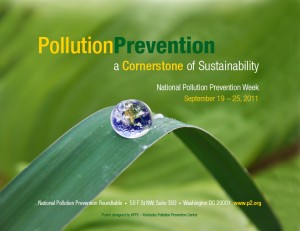 Happy Pollution Prevention (P2) Week! Celebrated during the third full week of September every year, P2 Week is a time to reflect on what you and/or your organization are currently doing to promote pollution prevention and sustainability, as well as a prime time to consider what more you could be doing. Check out the National Pollution Prevention Roundtable (NPPR) web site and the US EPA site for more information on activities taking place this week throughout the country; tips for increasing energy efficiency, reducing waste and sustainable practices; and news. (And of course, you can always browse through the online resources on the GLRPPR and P2Rx web sites for more information and best practices specific to your sector.)
Happy Pollution Prevention (P2) Week! Celebrated during the third full week of September every year, P2 Week is a time to reflect on what you and/or your organization are currently doing to promote pollution prevention and sustainability, as well as a prime time to consider what more you could be doing. Check out the National Pollution Prevention Roundtable (NPPR) web site and the US EPA site for more information on activities taking place this week throughout the country; tips for increasing energy efficiency, reducing waste and sustainable practices; and news. (And of course, you can always browse through the online resources on the GLRPPR and P2Rx web sites for more information and best practices specific to your sector.)
In the Great Lakes region, the Indiana Department of Environmental Management (IDEM) and the Indiana Partners for Pollution Prevention (P4P2) will be hosting the 14th Annual Pollution Prevention Conference and Trade Show on Thursday, September 22.
GLRPPR’s sister Pollution Prevention Resource Exchange (P2Rx) center, the Pacific Northwest Pollution Prevention Resource Center (PPRC) is hosting a 20th anniversary banquet for its regional P2 roundtable during P2 Week. Highlights will include a presentation by Dara O’Rourke, founder of the Good Guide, and former PPRC staff member.
And to kick off P2 Week, P2Rx has announced the launch of the National Sustainable Lodging Network, an online community of sustainable hospitality practitioners and an information clearinghouse to support the work of this community, found online at www.SustainableLodging.org. This site brings lodging operations together with federal, state, local, and tribal sustainable hospitality programs, including environmental agencies, tourism boards, and lodging associations. The goals for the site are to provide forums for sustainable hospitality practitioners to share information on practices and challenges; elevate sustainable hospitality programs and the facilities that participate in them; increase the adoption of sustainable hospitality practices nationwide; and foster innovation in sustainable lodging through the exchange of ideas.
If your organization or community is hosting a special event this week, tell us about it in the comments section of this post.


 Green Drinks events are currently held in 448 cities around the world, including many in the Great Lakes region.
Green Drinks events are currently held in 448 cities around the world, including many in the Great Lakes region.  own thing,” ensuring that the events suit the needs and interests of the local community. Each city can even come up with its own
own thing,” ensuring that the events suit the needs and interests of the local community. Each city can even come up with its own